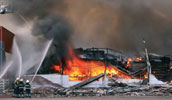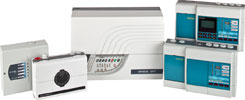

Saving lives is job no.1 – But what about the rest?
According to the National Fire Protection Association in the USA, more than 3000 lives and more than $10,6 billion dollars in damages were attributed to fires in the United States last year. A catastrophic fire can cause loss of life, damage to assets and inventory and lost productivity due to downtime. In fact, according to KPMG, 40% of businesses that suffer a catastrophic disaster, such as a major fire, go out of business in less than two years.
Security managers, well aware of the dangers presented by fire, have established detailed evacuation and response procedures to preserve and protect lives in the event of a blaze. In addition, the security industry has experienced significant innovation in recent years in the areas of fire alarms, suppression systems and monitoring technologies. These technologies and procedures save lives. But they do not do much to stop a fire before it progresses to the point where significant damage occurs to property and assets. This is due in large part to the time that lapses between the earliest stages of a fire and the point at which traditional fire detection and suppression systems are activated. Traditional smoke detection systems are typically activated when heavy concentrations of smoke reach sensors on the device, which most often occurs after a fire has reached full ignition.
Recently, an advanced and more proactive approach to fire security has been gaining awareness and adoption among security and fire and life safety managers – early warning smoke detection. Early warning smoke detection, or EWSD, refers to the application of policies and technologies to support a proactive approach to fire detection and prevention. This proactive approach is designed to help security and fire and life safety personnel identify a threat at the earliest stage of a fire’s progression. EWSD programs tightly integrate cutting-edge aspirating smoke detection technologies with physical security solutions to provide security and life safety managers with a holistic view of a fire event.
Four stages of fire progression
Before we dive deeper into EWSD programs and technologies, we must examine the four stages of fire progression. The first stage, the incipient stage, is when smoldering smoke is emitted before flames are present. The smoke level at this stage is typically very low and, in some cases, not visible to the human eye. In the second stage, the smoke becomes clearly visible and conventional detection techniques are initiated. Next, in stage three, flames are visible and this accelerates the fire into the fourth stage where heat detection initiates and fire suppression systems are often activated.
The entire principle behind EWSD is to activate an alarm early in the first stage of fire to initiate a response that preserves life and property by ensuring that a fire does not progress to the later stages.
Shortfalls of conventional solutions
There are several types of common smoke detection technologies often deployed in a facility – point detectors, beam detectors and rate of heat rise detectors. While these technologies are adequate in some scenarios, each has a shortfall that prevents it from being appropriate for an EWSD approach.
Point detectors, also called spot detectors, are one of the most common types of smoke detectors used today. Point detectors are passive in that they wait for smoke to enter a detection chamber where an optical sensor identifies the presence of smoke. A problem with point detectors is that dust, insects and other airborne debris can impede the flow of air and smoke into the detection chamber. This can lower sensitivity and minimise effectiveness.
Beam detectors bounce a beam of light between two sensors to detect the presence of smoke. When a significant level of smoke disrupts the beam, an alarm is activated. Unfortunately, beam detectors are prone to nuisance alarms from obstructions or building movement. These false alarms reduce confidence in the effectiveness of beam detectors and often lead to disablement.
Rate of heat rise detectors measure the rapid rise of ambient room temperature to identify the imminent threat of a fire. Rate of heat rise detectors are often integrated with fire suppression systems and are typically mounted on ceilings where heat from a fire collects. Unfortunately, a smouldering fire can produce low initial levels of heat, making these detectors ineffective for early detection.

Aspirating smoke detection solutions
A new breed of aspirating smoke detection (ASD) solutions are gaining rapid adoption among security and life safety managers. ASD solutions, such as VESDA by Xtralis, are designed to detect the earliest presence of a fire while it is still in the first stage of progression, before smoke may be visible to the human eye. The most effective ASD solutions address reliability issues found in conventional smoke detectors through an alternative approach to capturing and analysing air samples called aspiration.
Aspirating smoke detection solutions use multiple air sampling tubes, spread out across large open facilities, to capture and filter air samples. These samples are quickly transported through a dual-stage filter to remove dust and other contaminants that can cause false alarms with conventional smoke detectors. Finally, air samples pass through a highly sensitive centralised laser detection unit. If the presence of smoke is detected, alarm signals are processed and transmitted to centralised monitoring stations, as well as to integrated systems such as building management, equipment control or fire suppression systems. The entire process takes only seconds. Because aspirating detectors are actively sampling the air in a facility, they are tolerant of smoke dilution and are reliable in high airflow environments.
Warehouse test: three detection technologies in action
A series of fire tests for demonstration purposes were conducted by Xtralis, at Victoria University’s (VU) Werribee Campus Warehouse Testing Environment. The purpose of these demonstration tests was to illustrate the smoke detection capabilities of three detection technologies during the early developing stages of the fires and in a challenging environment (warehouse) that promotes smoke dilution due to a high ceiling height and the action of natural ventilation.
The three technologies compared included a VESDA air-sampling (aspirating) ASD solution, a point-type detector and a beam detector. Three small-scale fire/smoke tests were conducted using three fuels – smoke pellets, N-Heptane and timber logs. As you can see from the results in the table, the VESDA ASD solution outperformed the point and beam detectors. In many cases, the point and beam detector failed to active at all.

Historically, fire and life safety systems have been stove-piped or siloed from all other physical security systems within a facility but the growth in intelligent, standards-based fire and life safety, physical security and building management systems offers significant potential benefits as these two critical functions become integrated. By integrating fire alarms with other physical security systems, fire and life safety personnel can benefit from the broader visibility provided by cameras, as well as a multitude of access control, environmental and security sensors.
However, in order for physical security and fire and life safety to join forces, security personnel will need to become more familiar with the systems used to prevent against a fire-related disaster. Aspirating smoke detection solutions and their early warning approach are helping to breakdown silos and bridge the gap between this organisational division by providing a proactive and holistic view of a situation before it is able to escalate.
For more information, contact Lauren Sher, regional sales manager, Xtralis, +27 (0)82 446 7602, [email protected]

© Technews Publishing (Pty) Ltd. | All Rights Reserved.